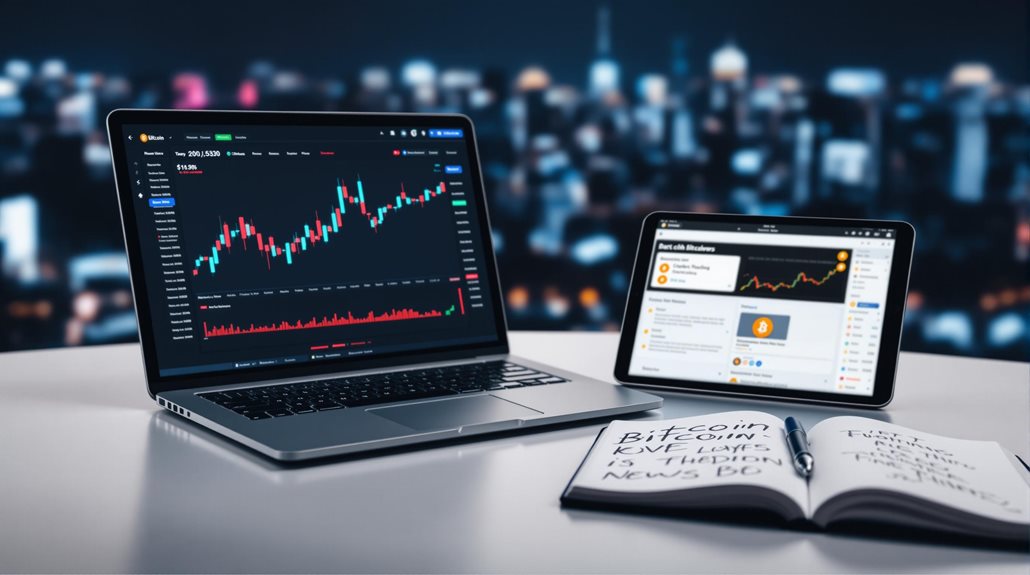Trading Bitcoin starts with choosing a secure cryptocurrency exchange like Coinbase or Kraken. New traders need to set up verified accounts with strong passwords and two-factor authentication. They can then develop trading strategies based on market analysis and begin with small transactions to gain experience. Different approaches include day trading, swing trading, or long-term investing. Bitcoin markets operate 24/7, and understanding the fundamentals helps traders navigate this dynamic environment.

Trading Bitcoin has become more accessible as cryptocurrency exchanges offer user-friendly platforms for buying and selling digital assets. The first step in trading Bitcoin is selecting a suitable exchange. Traders often compare different platforms based on their fees, security measures, and the variety of cryptocurrencies available. Popular platforms like Coinbase offer 240+ cryptocurrencies. They also check if the exchange follows regulations, has insurance policies, and maintains good trading volume for liquidity. Many traders use Kraken's security features for enhanced protection of their digital assets. Some traders review user feedback and confirm whether the platform supports their preferred trading pairs, like Bitcoin to US dollars.
Once they've chosen an exchange, traders need to set up and secure their accounts. This process typically involves identity verification, known as KYC (Know Your Customer). Many traders enable two-factor authentication and create strong passwords to protect their accounts. Traders can choose between hot wallets for convenient trading or cold storage devices for enhanced security. Some choose to store their Bitcoin in hardware wallets for added security, especially for long-term holdings. They also spend time learning the exchange's features and trading interface. Many beginners prefer centralized exchanges for their user-friendly interfaces and fiat-to-crypto conversion options.
Successful Bitcoin traders develop clear strategies before making trades. Some focus on day trading, while others prefer swing trading or long-term investing. They study technical analysis, which includes understanding chart patterns and market indicators. Many traders also follow cryptocurrency news and adoption trends as part of their fundamental analysis. They set specific points for entering and exiting trades and use risk management techniques like stop-loss orders to protect their investments.
The actual trading process starts with small transactions as traders gain experience. Many use limit orders to buy or sell Bitcoin at predetermined prices instead of market orders. They keep track of market trends and adjust their strategies based on performance. Traders maintain records of their transactions for tax purposes, as cryptocurrency trades are reportable events in many countries. They regularly review their trading results to identify what works and what doesn't.
Most experienced traders emphasize the importance of patience and continuous learning in Bitcoin trading. They understand that cryptocurrency markets operate 24/7 and can be highly volatile. Many successful traders start with small amounts while they learn the basics and gradually increase their trading activity as they gain confidence. They also recognize that different trading strategies work for different people, and what works in traditional markets might not apply to cryptocurrency trading. Regular monitoring and adjusting of trading strategies helps traders stay aligned with their goals while managing risks in the dynamic Bitcoin market.
Frequently Asked Questions
How Long Does It Take to Make Significant Profits From Bitcoin Trading?
The time to make significant profits from Bitcoin trading varies widely.
It's not a one-size-fits-all situation. Some day traders make quick gains in hours or days, while others wait months or years.
Market conditions, trading style, and initial investment all play a role.
Short-term traders might see results in days or weeks, medium-term traders in months, and long-term holders often wait years.
There's no guaranteed timeline for profits.
What Is the Minimum Amount of Money Needed to Start Trading Bitcoin?
There's no set minimum amount required to start trading Bitcoin. Different trading platforms have their own requirements.
Some let people start with as little as $5-$10, while others need $20 or more to open an account. Traders can buy small fractions of Bitcoin, so they don't need to purchase a whole coin.
Many popular exchanges allow small deposits through bank transfers or credit cards, though fees may apply.
Can I Trade Bitcoin Without Revealing My Identity?
While it's possible to trade Bitcoin with some degree of privacy, complete anonymity is hard to achieve.
Traders can use Bitcoin ATMs, peer-to-peer platforms, or decentralized exchanges that don't require ID verification. However, these methods often come with higher fees and increased risks.
Some people use privacy tools like VPNs or Bitcoin mixers to help mask their identity.
Privacy-focused cryptocurrencies like Monero offer built-in anonymity features.
Are Bitcoin Trading Profits Taxable in My Country?
Tax rules for Bitcoin profits aren't the same everywhere – they change from country to country.
Most nations do tax Bitcoin trading gains, but the rates and rules are different. Some places treat Bitcoin like property, while others see it as an investment or income.
Some countries don't tax crypto at all, like Portugal and Singapore, while others have strict rules with rates up to 55%, like Japan.
Which Countries Have Banned or Restricted Bitcoin Trading?
Several countries have completely banned Bitcoin activities. China, Egypt, Algeria, Nepal, and Bangladesh don't allow any crypto trading or mining.
Other nations have partial limits – India taxes crypto heavily, while Indonesia and Vietnam only ban its use for payments.
Some countries focus on banking restrictions, like Colombia and Iran, where banks can't handle crypto transactions.
The main reasons for these bans include concerns about financial risks, money laundering, and energy usage.





